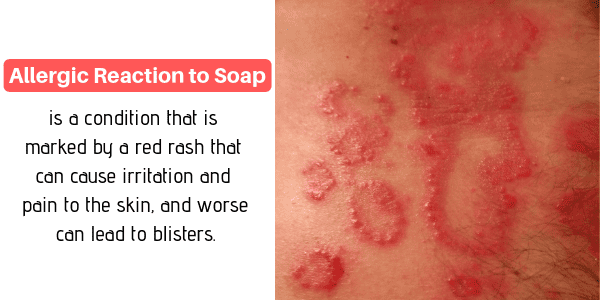4 Allergens in Soap That Lead to Dermatitis
Growing up we learn the importance of washing our hands often in practice of good hygiene. The rule of thumb is to wash our hands before meals, after using the restroom, and any time that we may think our hands are dirty. This can lead to multiple hand washings a day – which means a lot of soap being used to properly clean and eradicate the bacteria and odors left on your hands. However, sometimes after multiple hand washings we can form a skin rash on hands. In a study conducted with 1,300 people, it was found that 35% of the people experienced a hand rash from skin irritation, while 20% had atopic dermatitis and 19% had allergic contact dermatitis.
Dermatitis is any inflammation of the skin that leads to redness, scaling, itching, or tiny fluid-filled blisters. This can stem from an allergic reaction to certain chemicals that your body is exposed to like hand soap. The fastest way to develop allergic contact dermatitis is by applying something you are allergic to directly onto your bare skin as we do with hand soap.
What can you do if you develop allergic contact dermatitis to hand soap and what chemicals utilized in soap could be triggering this allergic reaction?
 Allergic Reaction to Soap
Allergic Reaction to Soap
Typically, a soap allergy is the result of a chemical or fragrance used within the composition of the soap. Those individuals that experience a soap allergy have an immune system that responds to the fragrance or chemical in soap as if it was something infectious entering the body. This reaction will cause the release of chemicals which causes both the inflammation and itching of the skin.
A potential danger to soap allergies is that the irritation will lead to scratching, and when you start itching a portion of the skin it will just cause additional inflammation and irritation. And even further, intense and aggressive scratching of the skin can lead to neurodermatitis which makes the inflamed skin take on a thick and unusually leathery appearance.
Signs of a Soap Allergy
An allergic reaction to soap is a condition that is marked by a red rash that can cause irritation and pain to the skin, and even worse it may lead to blisters on the affected skin. This form of allergy will generally appear within 24 to 48 hours after the soap has touched the skin and can last for up to four weeks after initial contact with the allergen. A soap allergy will be determined by a few key characteristics that can be detected by the individual or a medical professional. The first sign is inflammation of the skin which will be visible by redness, itching, and potentially swelling. A “patch” test can be used to confirm an allergic reaction to soap – this test contains chemicals suspected of causing the allergy which are applied to the skin. The patches are removed after 48 hours on the skin to determine if a reaction has formed on the skin to the tested chemicals.
Allergens in Hand Soap
The irony that a product designed to help you cleanse your skin can end up causing you a lot of pain and aggravation is not lost on us in reference to a hand soap allergy. However, due to specific chemicals that are used in the composition of hand soap is what ends up causing this ironic reaction. Below we are going to discuss the top 4 allergens found in hand soap that can be causing a potential allergic dermatitis reaction to your skin.

1.) Paraben
A commonly found preservative used in many hand soaps and cosmetics. Paraben’s are endocrine disruptive chemicals that are absorbed into the bloodstream and affect many of our body’s natural functions. Surprisingly enough, an allergic reaction to this preservative is fairly rare because of how commonly it is used in many cosmetic products, but the more often this is used in the same products that you use the increased likelihood of a reaction occurring to the skin.
A study conducted in 2004 against parabens found that the chemical was linked to breast cancer after trace amounts of methylparaben were found in breast cancer tumor biopsies. Whether or not the claims about parabens is true, it is important to be vigilant with what products you apply onto your skin – particularly hand soap.
2.) Coconut Diethanolamide
An allergic reaction to coconuts is rare, but not completely uncommon to have an allergic reaction when touching them. Coconuts are a commonly found ingredient in skin care products for both its delicious scent and its ability to moisturize/soften the skin. Coconut Diethanolamide is found in coconuts, this is a detergent that helps create a stable lather when you are washing with soap. This chemical can break down your skin’s oily barrier layer and dry it out, but some individuals will experience even more intense allergic reactions to the chemical.
Coconutethanolamide is found in barrier creams and hand protection foams, and as use occurs you may form sensitization to the chemical. This will lead to the development of a reaction after using the product for an extended period of time such as two or three months after use.
 3.) Fragrance
3.) Fragrance
The wonderful smells and scents of your hand soap are a big consideration when purchasing this item for many consumers. The different scents and fragrances available in this market is broad and this is all done through the use of fragrance chemicals that are used to compose the soap. The ingredient “fragrance” is a secret blend of esters, ketones, aldehydes, amines and more that are used to construct the wonderful smells of the hand soap. This concoction, however, makes it extremely difficult to construct allergy tests for fragrance as the chemicals used to create the fragrance is typically unknown.
Although fragrance doesn’t actually contribute to skin cleansing, it is one of the most common contact allergens used in soap.
4.) Sodium Lauryl Sulfate (SLS)
SLS is a detergent that does a good job of breaking up oil and grease. It also has properties which allow the soap to get frothy on your skin when you rub the chemical. When exposed to the skin SLS can contribute to contact dermatitis. We commonly believe that oil on our bodies is dirty, but the oil is what we need for skin protection. When SLS is used on the skin it will begin to break up greasy foreign substances and breaks up the layer of oil that keeps our skin from drying out.
Although SLS is not an allergen it does have the potential to provoke a reaction from the immune system – this is because it causes contact dermatitis and aggravate eczema by weakening that oily barrier on the skin. When you are exposed to this continually it can lead to reactions to other things that you may not have been allergic to beforehand.
Best Hand Soap for Sensitive Skin
The chemical-free options available for hand soaps are becoming more and more prevalent and readily accessible in stores. However, what can you do when the smells and chemicals from a prior hand soap will not be removed from the skin on your hands?
The EnviroKlenz Hand Soap integrates a patented odor-neutralizing earth mineral technology in combination with a Castile-based soap to physically break down the odors and prevent them from re-depositing back onto your hands. The ingredients in the EnviroKlenz Hand Soap are all chemical-free and nontoxic and these include Castile soap, vegetable glycerin, water, magnesium hydroxide, magnesium oxide, zinc oxide, and titanium dioxide.
The easy application and effective nature of the hand soap makes it ideal for any and all chemical odor elimination on the skin.
When purchasing a hand soap, it is important to be aware of the ingredients found within this product. If you experience an allergic reaction to hand soap, turning to safe nontoxic soaps will be ideal to reduce allergens and remove stubborn chemical smells from your hands.

Comments
Post a Comment